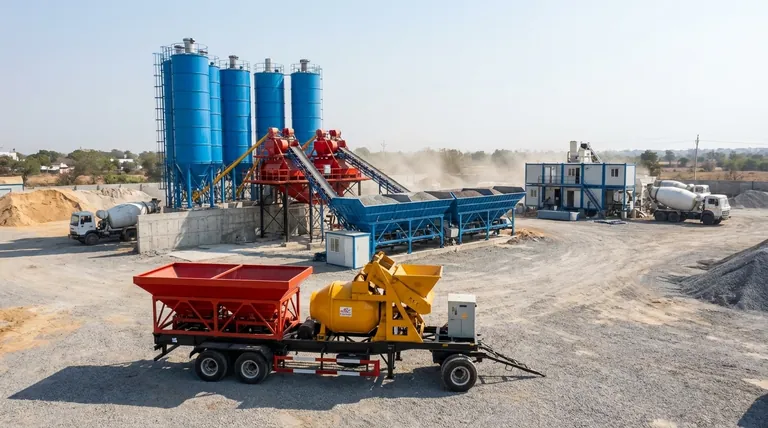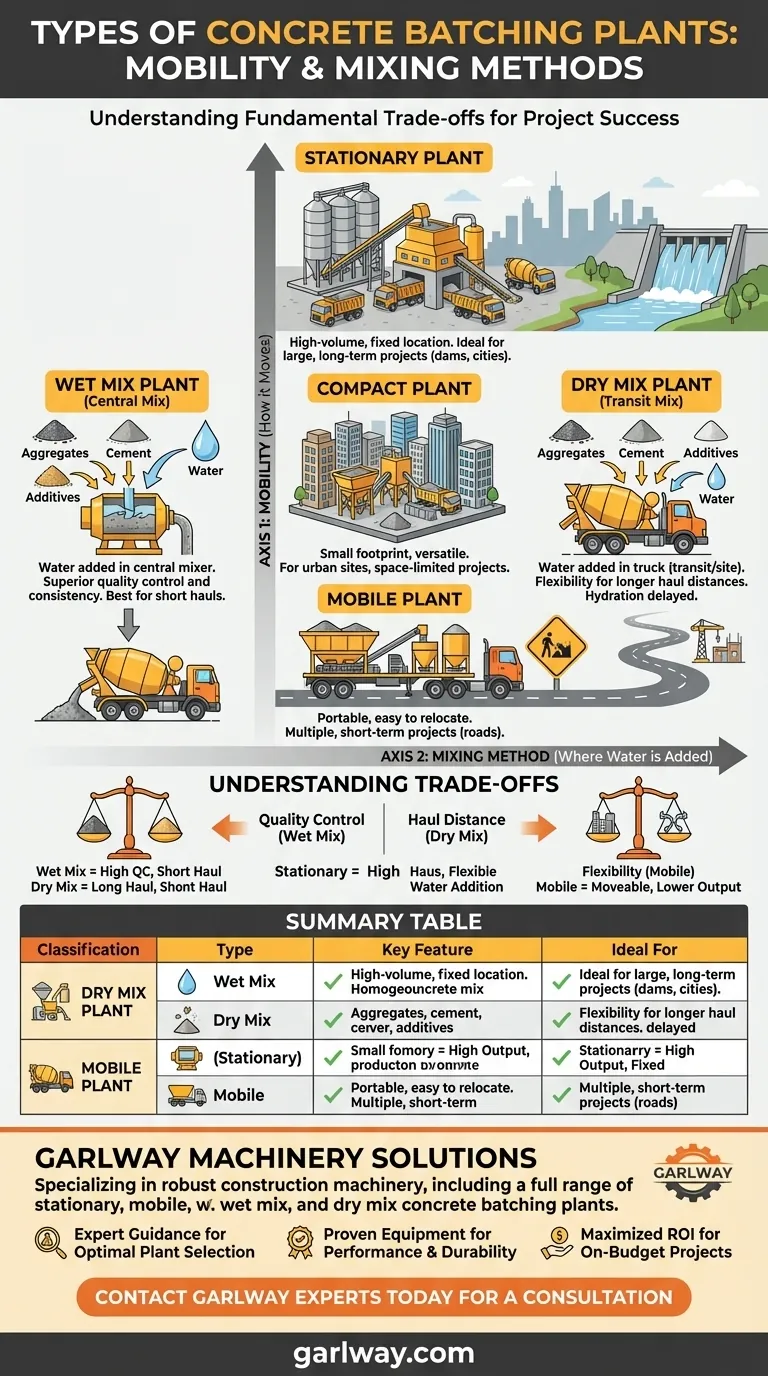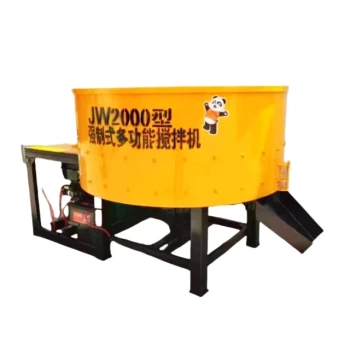At its core, a concrete batching plant is classified based on two independent factors: its mobility and its mixing method. This means a plant can be stationary or mobile, and it can also be a wet mix or dry mix plant, allowing for several combinations depending on the project's requirements.
The most critical distinction is not just listing types, but understanding that the choice between them represents a fundamental trade-off between centralized quality control (wet mix) and logistical flexibility (dry mix), and between permanence (stationary) and portability (mobile).

The Primary Classifications: Mobility and Mixing
The most useful way to understand batching plants is to analyze them across two separate axes. A plant's final configuration is a combination of a choice from each category.
Axis 1: Mobility (How it Moves)
This classification is based on the plant's portability and intended permanence.
Stationary Concrete Batching Plant
A stationary plant is designed and constructed for a single location. It is built on concrete foundations for long-term, high-volume production.
These are the workhorses for ready-mix companies supplying a metropolitan area or for massive civil engineering projects like dams and airports that require a consistent concrete supply for years.
Mobile Concrete Batching Plant
A mobile plant is designed for easy transport and rapid assembly. The main components are mounted on a chassis with wheels, allowing it to be towed to different job sites.
This type is ideal for contractors working on multiple, short-term projects in different locations, such as road construction or building foundations across a large development.
Compact Concrete Batching Plant
This is a subtype that prioritizes a small footprint. It can be either stationary or semi-mobile and is engineered to fit into tight urban spaces or smaller project sites where a full-sized plant is not feasible.
Axis 2: Mixing Method (Where Water is Added)
This classification defines where the concrete is fully mixed into its final state.
Wet Mix Plant (or Central Mix Plant)
In a wet mix plant, all ingredients—aggregates, cement, additives, and water—are mixed together in a central mixer at the plant itself.
The resulting homogenous concrete is then discharged into an agitator truck or a standard dump truck for short hauls. This method offers superior quality control and consistency because the mixing process is precisely managed by the plant's systems.
Dry Mix Plant (or Transit Mix / Ready Mix Plant)
A dry mix plant combines all ingredients except for water. The aggregates and cement are weighed and discharged directly into a concrete mixer truck.
Water is then added to the truck's drum either during transit or upon arrival at the project site. This provides flexibility for longer haul distances, as the concrete's hydration process doesn't begin until it's close to the point of delivery.
Understanding the Trade-offs
Choosing a batching plant involves balancing competing project demands. The right choice is never absolute; it is always relative to the project's goals.
Quality Control vs. Haul Distance
The core trade-off between mixing methods is clear. Wet mix plants offer excellent quality control and consistency but limit the practical delivery radius before the concrete begins to set.
Conversely, dry mix plants sacrifice some of the centralized control over the water-cement ratio in exchange for the ability to deliver concrete over much longer distances.
Production Volume vs. Flexibility
Stationary plants are built for massive, continuous output but are completely inflexible in their location. Their high initial investment is justified by their production capacity and longevity.
Mobile plants offer unparalleled flexibility to move where the work is, but they typically have a lower production capacity and may require more frequent maintenance due to the stresses of relocation.
Initial Investment vs. Site Requirements
A large stationary plant represents a significant capital investment but operates efficiently at scale. A mobile or compact plant has a lower barrier to entry but might be less efficient for extremely high-volume, single-site demands.
Making the Right Choice for Your Project
Selecting the appropriate plant configuration is critical for ensuring efficiency, quality, and cost-effectiveness.
- If your primary focus is supplying a large, single-site project (like a dam or precast factory) with the highest quality concrete: A Stationary Wet Mix Plant is the definitive choice.
- If your primary focus is serving a large metropolitan area from a central hub with many different job sites: A Stationary Dry Mix Plant provides the necessary production scale and delivery flexibility.
- If your primary focus is executing multiple, geographically separate projects (like highway construction): A Mobile Dry Mix Plant offers the ideal combination of portability and logistical range.
- If your primary focus is a remote but high-specification project requiring tight quality control on-site: A Mobile Wet Mix Plant brings the precision of a central mixer directly to the job.
Ultimately, understanding these fundamental types and their inherent trade-offs empowers you to align your equipment precisely with the demands of your project.
Summary Table:
| Classification | Type | Key Feature | Ideal For |
|---|---|---|---|
| By Mobility | Stationary Plant | High-volume, fixed location | Large, long-term projects (dams, cities) |
| Mobile Plant | Portable, easy to relocate | Multiple, short-term projects (roads) | |
| Compact Plant | Small footprint, versatile | Urban sites, space-limited projects | |
| By Mixing Method | Wet Mix Plant | Central mixing, superior quality control | Projects requiring high consistency |
| Dry Mix Plant | Mixing in truck, long haul distance | Projects with distant delivery points |
Ready to Choose the Right Batching Plant for Your Project?
Navigating the trade-offs between mobility, mixing methods, and project requirements is complex. The right batching plant is critical for your project's efficiency, cost, and quality.
GARLWAY specializes in providing robust construction machinery solutions. We offer a full range of concrete batching plants, including stationary, mobile, wet mix, and dry mix models, designed to meet the specific needs of construction companies and contractors globally.
Partner with GARLWAY to benefit from:
- Expert Guidance: Our specialists will help you select the optimal plant type for your project's scale, location, and quality demands.
- Proven Equipment: Reliable winches, concrete mixers, and batching plants built for performance and durability.
- Maximized ROI: The correct equipment choice ensures your project stays on budget and on schedule.
Don't leave your project's success to chance. Contact our GARLWAY experts today for a personalized consultation and discover the perfect batching plant solution for you!
Visual Guide

Related Products
- HZS120 Ready Mix Concrete Batching Plant Commercial Mud Cement Mixer
- HZS75 Concrete Batching Plant Cement Mixer Price Concrete Mixer Bunnings Mixing Plant
- HZS180 Ready Mix Concrete Plant for Foundations with Sand and Cement
- HZS35 Small Cement Concrete Mixing Batch Plant
- JW1000 Mobile Cement Mixer Concrete Mixer Truck and Batching Plant
People Also Ask
- How to start a concrete plant business? A Step-by-Step Guide to Launching Your Venture
- What are the advantages of ready mix concrete? Higher Quality, Efficiency & Cost Savings
- How do you maintain a concrete batching plant? Maximize Uptime & Extend Equipment Life
- What are the advantages of a concrete plant? Achieve Consistent Quality & Efficiency for Large-Scale Projects
- What are the disadvantages of ready mix concrete? Navigating Logistical and Cost Challenges

















